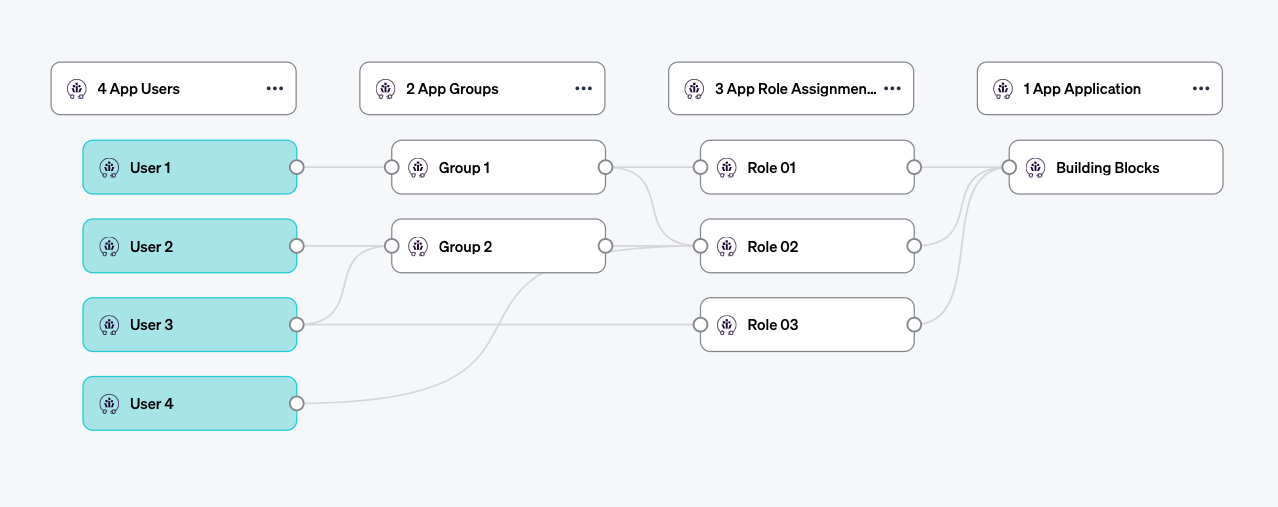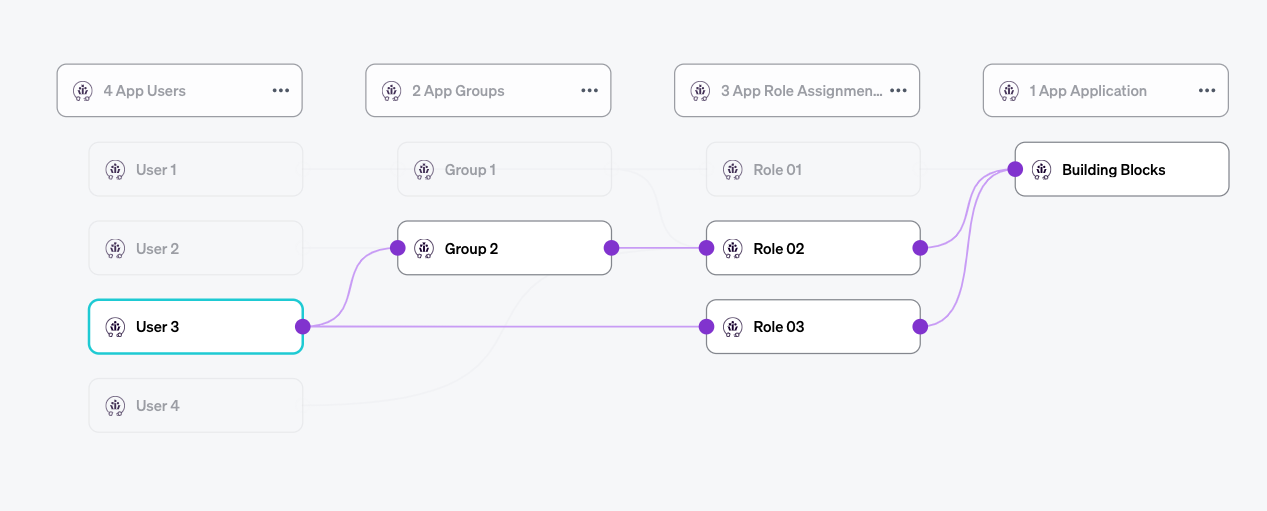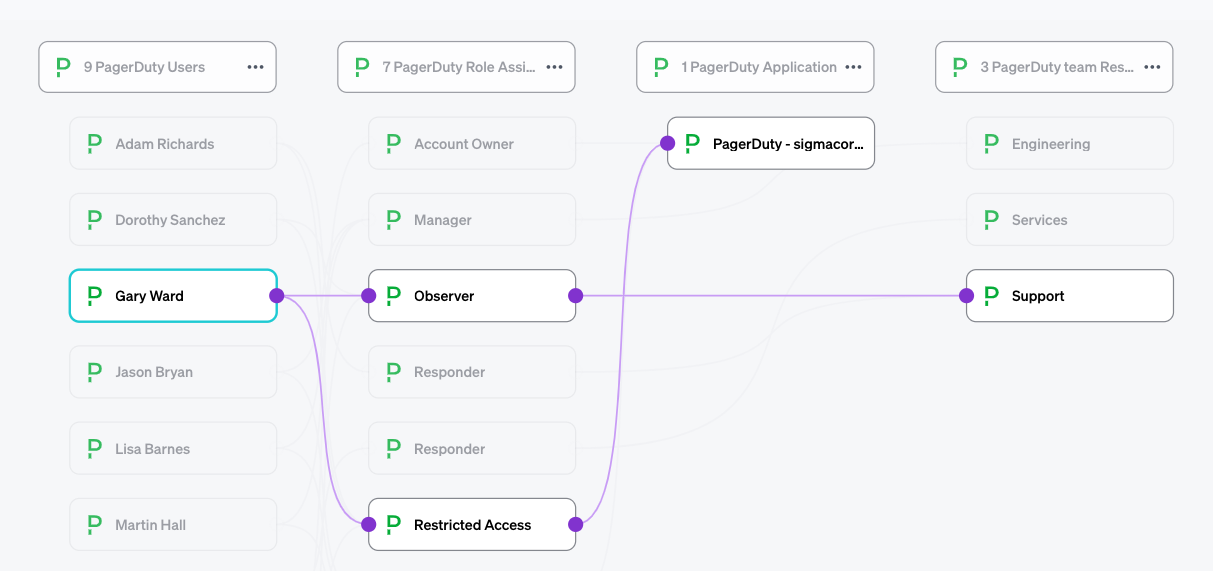Appearance
Modeling Apps Using the Application Template
The OAA Application template allows for representing the basic elements of an application and is flexible to allow for multiple different patterns.
The custom application template provides a framework for describing:
- Who: Users, Groups, and other identities
- What: Application, resources, sub-resources
- How: Permissions, canonical mappings, roles, authorization

Application
The Application itself is the first entity as part of the Application submission. The application has a name and a type. The name can be specific such as "West Production" and the type is typically the vendor, technology, or product such as "GitLab". Veza will group the rest of the entities by the application type such as "GitLab Users" across all instances of an application type, however, entities will only be directly associated with the application they are submitted with. Applications additionally can have custom properties assigned to further enrich the data. This can be especially useful to distinguish between multiple instances of an application type.
Local Users

The Local User object represents the local user of the application. It can store application-specific information such as the identifier, name, active status, last login time, and custom properties specific to the application. An external Identity can be associated with the user, enabling Veza to connect the source Identity Provider (IdP). This creates a connection in the Access Graph between the application user and a source identity such as Okta or Active Directory. Users can be added to groups, or have roles and permissions directly assigned.
Local Groups
Local Groups represent a collection of users. Groups can store additional metadata about the group to support search and filters. Groups can also contain other groups, to model applications that support nested groups. Groups can have role and permission assignments in the application.
Local Roles
Local Roles represent a collection of permissions within an application. When a user or group is assigned a role, that user or group is assigned all the permissions from the role. Like other entities, roles can contain additional properties to enrich the metadata of the role, such as description or application-specific attributes.
Permissions
OAA allows for expressing the permissions of the application in its own terms. In the Application Template, permissions are defined by application-specific terms such as "Close Ticket" or "Approve User". These permissions will also allow for setting corresponding Veza Canonical Permissions such as "Data Read", "Data Write", or "Metadata Read". This enables search and filters across permissions using CRUD-like equivalents.
Available Canonical Permissions: - DataRead - DataWrite - DataCreate - DataDelete - MetadataRead - MetadataWrite - MetadataCreate - MetadataDelete - NonData - Uncategorized
Resources

Resources can be used to model components within applications that users can be assigned roles or permissions on. For example, an OAA resource may be used to model a Project in an application like Jira. Users can have different roles in different projects, by assigning the correct users or groups their respective roles on the resources. Each resource has a Type which Veza uses when displaying and searching the resources for an application. Applications can have multiple types of Resources. Like other entities, resources can have properties containing additional resource metadata.
Examples
Below are some examples of how applications may be modeled in OAA. These examples have all been implemented using the Application template.
PagerDuty
PagerDuty is an example of an application where users can have roles at the application level (global roles) but also within the PageDuty Teams that a user is a member of. Understanding which Users are part of which Teams and what level of access they have in those Teams is important for reviewing access in an application like PagerDuty. The OAA Application template can be used to model this type of application using the following mappings.
| PagerDuty Entity | OAA Application | Notes |
|---|---|---|
| User | Local User | |
| Team | Local Group | To group the Users |
| Application Role | Local Role | Applied to the Application |
| Team | Local Resource | To represent the User's role in the Team |
| Team Role | Local Role | Applied to the Team Resource |
With this model, Veza can show the levels of access users have within the overall Application and their individual Teams. In this example, we can see the User Gary Ward has the Role "Restricted Access" in the PagerDuty Application, and the "Observer" Role in the "Support" Team Resource.

Python Code for the PagerDuty connector can be referenced on the Veza GitHub
GitLab
GitLab is a good example of a more complex application that can be modeled using the Veza OAA Application Template. By correctly modeling the applications, Veza can show which users have access to GitLab Groups and Projects to show details beyond just "who has access to GitLab?"
| GitLab | OAA Application |
|---|---|
| User | Local User |
| Group | Resource |
| Project | Sub Resource |

- Each GitLab User is represented with the Application Local User. GitLab assigns each user a unique ID number to each user, using this as the ID for the Local User makes it easier when associating groups and roles to Projects later. The Local User also allows for setting properties to represent the user's state such as
is_activeorlast_login_at, custom properties to represent GitLab-specific properties can also be utilized like if the user is licensed or not. The identity for the Local User is set to enable OAA connection to source Identity Providers configured in Veza. - A GitLab Group represents both a collection of Users, a collection of Projects, and possibly other sub-groups. This is a good example of where some mapping needs to be done to represent GitLab using the Application Template. Since GitLab Users have a specific role in the GitLab Group, it is correct to represent the GitLab Group as an OAA Resource. Members are assigned an OAA Local Role to the Resource that represents the GitLab Group, denoting their level of access (Owner, Developer, Guest, and so on). Veza can return all the members of a GitLab Group by querying for the relation between the OAA User and the OAA Resource. Additionally, the role within the GitLab Group is preserved by the OAA Role.
- GitLab Roles are assigned to users or Groups as part of a Group or Project. GitLab is an example of an application with fixed roles where the roles and behaviors are coded directly into the application. For the OAA Application Template, the corresponding Local Roles are also coded directly into the connector by reviewing the GitLab documentation on available roles and the permissions associated with the roles. It is not always necessary to capture every Permission as part of the Local Role. Which permissions are important and how much detail is needed will be determined by the queries you intend to run, and the scope of Access Reviews that will be conducted in Veza.
- GitLab Projects are also represented as an OAA Sub-Resource with the type set to Project. The Project Sub-Resource is added to the corresponding Group resource. Local User and Local Groups can be assigned roles on the project based on their direct assignments. In the case of GitLab, permissions can be inherited from above. This is an optional behavior for permissions, which can be set to automatically apply to sub-resources, or only apply directly to the assigned resources. Additionally, permissions can be set to apply to certain types of resources so that roles can be used across resources and only the correct permissions will be applied.
Python Code for the GitLab connector can be referenced on the Veza GitHub